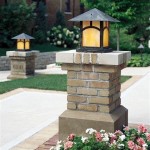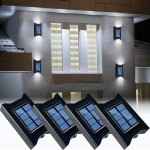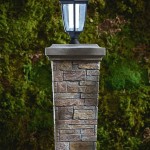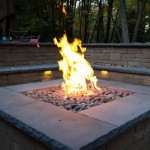Outdoor Lights For Concrete Steps And Stairs
Navigating outdoor spaces safely and effectively after dark requires careful consideration of lighting. Concrete steps and stairs, in particular, pose a significant risk if poorly illuminated. Choosing the right outdoor lights not only enhances safety but also contributes to the aesthetic appeal of a property. This article explores various lighting options suitable for concrete steps and stairs, highlighting their features, benefits, and installation considerations.
The primary function of outdoor step lighting is to prevent accidents. Inadequate or absent lighting can lead to missteps, falls, and injuries, especially in areas with uneven terrain or changing weather conditions. Well-placed lights clearly define the edges of each step, providing visual cues that allow individuals to navigate the stairs with confidence. Beyond safety, outdoor lighting can transform a utilitarian space into an inviting and visually appealing feature of a property. Strategically positioned lights can accentuate the texture and form of the concrete, create a welcoming ambiance, and enhance the overall architectural design.
There are several factors to consider when selecting outdoor lights for concrete steps and stairs. These include the type of light source, the mounting location, the level of brightness, the energy efficiency, and the overall aesthetic style. Each of these aspects plays a vital role in determining the effectiveness and suitability of the lighting solution.
Types of Outdoor Lights for Concrete Steps and Stairs
A wide variety of lighting options are available, each with its own advantages and disadvantages. The selection process should consider the specific needs and aesthetic preferences of the property owner.
1. Step Lights: These lights are specifically designed to be recessed into the vertical risers of the steps. They provide a subtle, downward-facing light that illuminates the tread of each step without creating glare. Step lights are typically small and discreet, blending seamlessly with the surrounding concrete. They are available in a variety of styles, including round, square, and rectangular designs, and can be powered by either low-voltage or line-voltage electricity. The installation of step lights usually requires cutting into the concrete risers, which may necessitate professional assistance. However, the clean and integrated look they provide makes them a popular choice.
2. Path Lights: Path lights are designed to illuminate pathways but can also be used effectively to light steps and stairs. They typically consist of a light fixture mounted on a stake or post, which is then inserted into the ground alongside the steps. The light is directed downwards, creating a soft, diffused illumination. Path lights are relatively easy to install and can be moved or repositioned as needed. They are a good option for temporary or rental properties where permanent installations are not feasible. However, they may be more susceptible to damage from weather or vandalism than recessed step lights.
3. Post Lights: If the steps are flanked by railings or posts, post lights can be an elegant and functional solution. These lights are mounted on top of the posts, providing a widespread illumination that covers a larger area. Post lights are available in a variety of styles, from traditional lanterns to modern, minimalist designs. They can be powered by electricity or solar energy, offering flexibility in terms of installation and energy consumption. The height of the posts and the design of the fixtures should be carefully considered to ensure adequate illumination without creating excessive glare.
4. String Lights: String lights offer a decorative and versatile option for lighting outdoor steps and stairs. They consist of a series of small bulbs strung along a length of wire, which can be draped along railings, wrapped around posts, or hung overhead. String lights create a warm and inviting ambiance, adding a touch of festivity to the outdoor space. They are relatively inexpensive and easy to install, making them a popular choice for informal settings. However, string lights may not provide sufficient illumination for safety purposes and should be used in conjunction with other types of lighting.
5. LED Strip Lights: LED strip lights are a flexible and energy-efficient option for lighting concrete steps and stairs. They consist of a thin, flexible strip of LEDs that can be cut to length and adhered to various surfaces. LED strip lights can be mounted under the overhang of each step, creating a subtle and continuous line of light. They are available in a variety of colors and brightness levels, allowing for customization of the lighting effect. LED strip lights are relatively easy to install and consume very little energy, making them an environmentally friendly choice. They are also resistant to water and weather, making them suitable for outdoor use.
6. Solar Powered Lights: Solar-powered lights offer an environmentally friendly and cost-effective solution for illuminating concrete steps and stairs. These lights use photovoltaic cells to convert sunlight into electricity, which is then stored in a battery. At night, the battery powers the light. Solar-powered lights are easy to install, as they do not require any wiring. They are also energy-efficient, as they do not consume any electricity from the grid. However, their performance depends on the amount of sunlight they receive, so they may not be as bright or reliable in shaded areas or during periods of prolonged cloud cover. Solar lights are available in a variety of styles, including step lights, path lights, and post lights.
Key Considerations for Installation and Placement
Proper installation and placement of outdoor lights are crucial for ensuring both safety and aesthetic appeal. Several factors should be taken into account during the planning and execution phases.
1. Electrical Safety: When working with electrical wiring, it is essential to prioritize safety. All electrical work should be performed by a qualified electrician to ensure compliance with local codes and regulations. Outdoor lighting fixtures should be specifically designed for outdoor use and rated to withstand the elements. Ground fault circuit interrupters (GFCIs) should be installed to protect against electrical shock. Wiring should be properly insulated and protected from moisture and physical damage. Before digging, it is important to contact the local utility company to locate underground utilities and avoid damage.
2. Light Distribution and Glare: The goal of outdoor step lighting is to provide adequate illumination without creating excessive glare. Glare can impair vision and make it difficult to see the steps clearly. To minimize glare, choose fixtures with shielded or diffused lenses. Position the lights so that they are directed downwards, away from the eyes. Consider the height and spacing of the lights to ensure even distribution of light across the steps. Avoid using excessively bright bulbs, as this can create a harsh and uncomfortable lighting effect.
3. Mounting Techniques: The method of mounting the lights will depend on the type of fixture and the construction of the steps. Recessed step lights require cutting into the concrete risers, which may necessitate the use of specialized tools and techniques. Surface-mounted lights can be attached to the concrete using screws, anchors, or adhesives. Path lights are typically inserted into the ground alongside the steps using stakes or posts. Post lights are mounted on top of existing posts or railings. When mounting lights, ensure that they are securely fastened and resistant to movement or damage. Consider the potential for water intrusion and take steps to seal any gaps or openings.
4. Zoning and Local Regulations: Before installing outdoor lighting, it is important to check local zoning ordinances and regulations. Some municipalities have restrictions on the type, brightness, and placement of outdoor lights. These regulations are designed to minimize light pollution and prevent disturbance to neighbors. Compliance with local regulations is essential to avoid fines or other penalties.
Selecting the Right Light Source
The type of light source used in outdoor step lighting significantly impacts its energy efficiency, lifespan, and overall performance. There are several options to consider, each with its own characteristics.
1. LED (Light-Emitting Diode): LEDs are the most popular choice for outdoor lighting due to their energy efficiency, long lifespan, and durability. They consume significantly less energy than traditional incandescent or halogen bulbs, resulting in lower electricity bills. LEDs also have a much longer lifespan, lasting up to 50,000 hours or more. They are resistant to shock and vibration, making them ideal for outdoor use. LEDs are available in a variety of colors and brightness levels, allowing for customization of the lighting effect. They are also dimmable, allowing for further control over the light output. LEDs are generally more expensive than other types of light sources, but their long lifespan and energy savings make them a cost-effective choice in the long run.
2. Halogen: Halogen bulbs are a type of incandescent bulb that produces a bright, white light. They are more energy-efficient than traditional incandescent bulbs but less energy-efficient than LEDs. Halogen bulbs have a shorter lifespan than LEDs, typically lasting around 2,000 hours. They also generate a significant amount of heat, which can be a safety concern in some applications. Halogen bulbs are relatively inexpensive, but their shorter lifespan and higher energy consumption make them a less desirable option than LEDs for outdoor lighting.
3. Incandescent: Incandescent bulbs are the oldest and least energy-efficient type of light source. They produce a warm, yellow light, but they consume a large amount of energy and have a short lifespan, typically lasting around 1,000 hours. Incandescent bulbs are also fragile and susceptible to damage. They are generally not recommended for outdoor lighting due to their high energy consumption and short lifespan.
4. Solar: Solar-powered lights use photovoltaic cells to convert sunlight into electricity. They offer an environmentally friendly and cost-effective solution for outdoor lighting. Solar lights are easy to install, as they do not require any wiring. They are also energy-efficient, as they do not consume any electricity from the grid. However, their performance depends on the amount of sunlight they receive, so they may not be as bright or reliable in shaded areas or during periods of prolonged cloud cover.
In conclusion, selecting the appropriate outdoor lighting for concrete steps and stairs requires careful consideration of safety requirements, aesthetic preferences, and practical considerations. By understanding the different types of lighting options available, the key factors to consider during installation, and the characteristics of various light sources, property owners can create a safe, functional, and visually appealing outdoor space.

Mini Thin Hooded Led Step Light Broe Volt Lighting

Truly Innovative Garden Step Lighting Ideas Club Outdoor Stair Stairs Strip

Hardscaping 101 Stairway Lighting Gardenista Concrete Stairs Step

How To Add Lights In Concrete Steps Network

75 Beautiful Modern Patio Pictures Ideas Outdoor Stair Lighting Stairs Step

Recessed Led Stair Lights Outdoor Indoor Luzes Para Escadas De Concreto Iluminação Pátio

Create Outdoor Ambiance With Deck Lighting Ideas Advice Lamps Plus

Exterior Stair Recessed Step Light Asymmetrical Concrete Stairs Lighting

2301 Lightstan Outdoor Indoor Led Step Stair Light Black Grey

Solar Step Lights 2 Pack Outdoor Stair Warm White Triangles Decks Ip67auto On Off Decoration For Patio Yard Drivewa Com
Related Posts







